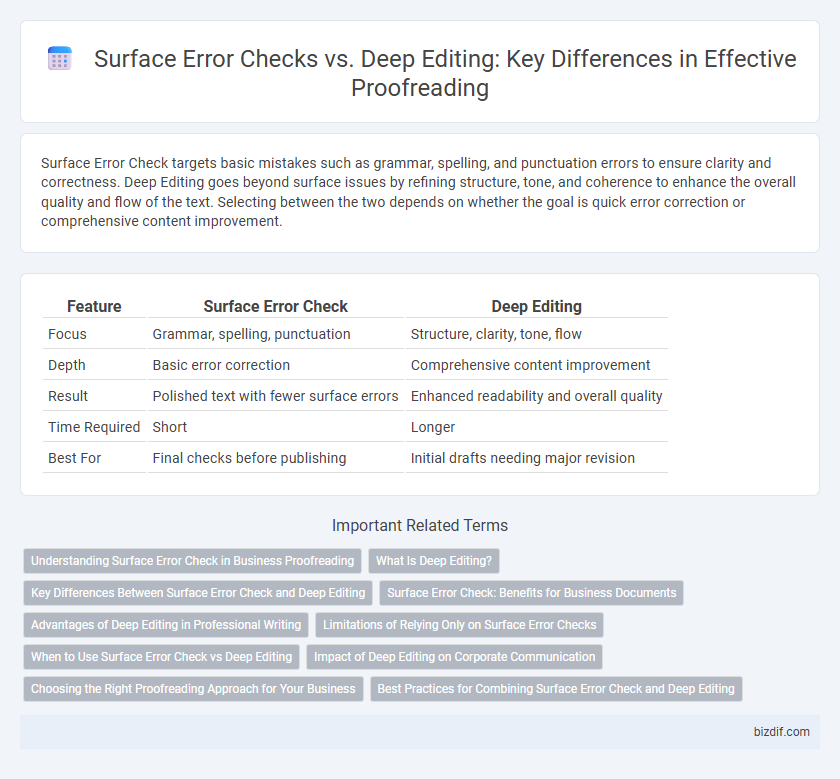Surface Error Check targets basic mistakes such as grammar, spelling, and punctuation errors to ensure clarity and correctness. Deep Editing goes beyond surface issues by refining structure, tone, and coherence to enhance the overall quality and flow of the text. Selecting between the two depends on whether the goal is quick error correction or comprehensive content improvement.
Table of Comparison
| Feature | Surface Error Check | Deep Editing |
|---|---|---|
| Focus | Grammar, spelling, punctuation | Structure, clarity, tone, flow |
| Depth | Basic error correction | Comprehensive content improvement |
| Result | Polished text with fewer surface errors | Enhanced readability and overall quality |
| Time Required | Short | Longer |
| Best For | Final checks before publishing | Initial drafts needing major revision |
Understanding Surface Error Check in Business Proofreading
Surface error check in business proofreading involves identifying and correcting basic mistakes such as typos, grammatical errors, and punctuation issues to ensure clarity and professionalism. This process targets visible flaws that can undermine the credibility of business documents like reports, emails, and proposals. Effective surface error checking improves communication accuracy and supports the overall quality control of corporate content.
What Is Deep Editing?
Deep editing involves a comprehensive review of a text's structure, content, and style to enhance clarity, coherence, and overall impact beyond simple surface corrections. This process addresses issues such as logical flow, consistency, tone, and argument strength, which are often overlooked in a surface error check. Writers seeking to transform drafts into polished, professional-quality documents benefit most from deep editing techniques.
Key Differences Between Surface Error Check and Deep Editing
Surface error check focuses on identifying and correcting basic mistakes such as spelling, grammar, punctuation, and typographical errors to ensure text clarity. Deep editing involves a thorough examination of content structure, style, tone, and coherence, enhancing overall readability and effectiveness. Key differences include the scope of analysis, with surface checks addressing superficial errors and deep editing targeting substantive improvements in writing quality.
Surface Error Check: Benefits for Business Documents
Surface error check enhances business documents by swiftly identifying and correcting spelling, grammar, and punctuation mistakes. This process ensures clarity and professionalism, reducing potential misunderstandings in corporate communication. Efficient surface error checking saves time and resources while maintaining document accuracy for business success.
Advantages of Deep Editing in Professional Writing
Deep editing enhances the clarity, coherence, and overall quality of professional writing by addressing not only surface errors like grammar and punctuation but also refining the structure, tone, and style. This comprehensive approach ensures the message is effectively communicated and aligned with the target audience's expectations. In contrast, surface error checks may miss deeper narrative inconsistencies, limiting the text's impact and professionalism.
Limitations of Relying Only on Surface Error Checks
Relying solely on surface error checks limits the ability to identify deeper issues such as structural inconsistencies, tone mismatches, and clarity problems that affect overall readability. Surface error tools primarily catch spelling, grammar, and punctuation mistakes but overlook semantic accuracy and contextual coherence. This narrow focus can result in texts that are technically correct but fail to effectively communicate the intended message or engage the target audience.
When to Use Surface Error Check vs Deep Editing
Surface error check is ideal for final reviews targeting grammar, punctuation, and spelling mistakes to ensure polished and error-free text. Deep editing is necessary when restructuring content, improving clarity, and enhancing tone or style to maximize overall readability and coherence. Choose surface error checking for straightforward corrections and deep editing when the document requires substantial content refinement.
Impact of Deep Editing on Corporate Communication
Deep editing significantly enhances corporate communication by improving clarity, tone, and message consistency, which surface error checks often overlook. It refines complex ideas and industry-specific terminology, ensuring the content aligns with the company's brand voice and strategic goals. This thorough approach minimizes misunderstandings and strengthens stakeholder trust, ultimately boosting the corporation's professional reputation.
Choosing the Right Proofreading Approach for Your Business
Surface error check targets basic mistakes such as spelling, grammar, and punctuation, ensuring your business documents maintain professional appearance and clear communication. Deep editing involves comprehensive content revision, including structure, tone, and clarity, enhancing overall readability and impact for strategic business materials. Selecting the right proofreading approach depends on your document's purpose, audience, and desired level of polish to align with your brand's communication goals.
Best Practices for Combining Surface Error Check and Deep Editing
Combining surface error checks and deep editing enhances document quality by first addressing grammar, punctuation, and spelling errors before focusing on structure, clarity, and style. Best practices include using automated tools for initial surface checks to quickly catch obvious mistakes, followed by thorough manual deep editing to refine coherence and argument strength. Integrating these methods in stages ensures comprehensive revisions, improving readability and overall professionalism.
Surface Error Check vs Deep Editing Infographic

 bizdif.com
bizdif.com